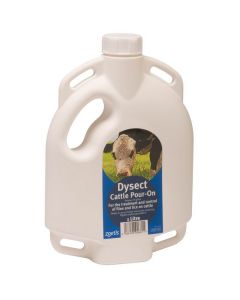Lice populations are highest in cattle kept indoors
Lice populations are highest in cattle kept indoors during the winter and severe infestations can lead to the disruption of feeding patterns, self-inflicted trauma, and reduced weight gain. It is important to consider lice control at housing to prevent welfare issues and production losses.
There are four species of lice that can affect cattle in the UK: the biting or chewing louse Bovicola Bovis and the blood-sucking lice Linognathus vituli, Haematopinus eurysternus and Solenopotes capillatus. The life cycle, which takes three weeks, is similar for all species and consists of an egg, three nymph stages and an adult, all of which take place on the cattle.
What are the signs of lice in cattle?
Most housed cattle will have lice infestations, however, these are usually asymptomatic. There may only be minimal skin lesions observed on lightly infested animals and close examination may be required to find lice.
Heavy infestations can lead to clinical signs including anaemia from a high burden of sucking lice, pruritus (itching), hair loss, stress and poor general condition. Young animals are more susceptible to severe clinical consequences and animals on a low plane of nutrition are also at risk. Other diseases may predispose animals to severe infestations.
What are the risk factors of lice?
Risk factors for lice include heat, mixing of animals of different ages, dark housing and long hair (non-shaved animals). Housed cattle in winter meet these criteria so lice numbers can build up quickly.
A lice outbreak can be diagnosed by close inspection of the skin with a magnifying glass, particularly around the neck, tail head and inner thigh. A microscope can be used to differentiate the different lice species.
What are the treatment options for lice?
One treatment is usually effective for treating lice if combined with suitable biosecurity to avoid reinfestation, however, if there is a heavy burden another treatment may be required.
Pour on or spot-on preparations containing synthetic pyrethroids (such as Fly and Lice Spot On or Dysect) are effective against chewing and sucking lice. Pour on preparations of 3-ML anthelmintics (e.g. CYDECTIN Cattle Pour-On or CYDECTIN TriclaMox) will remove all types of lice, however, injectable 3-MLs will only remove sucking lice, not chewing lice. It is important to remember that the 3-MLs also treat for internal parasites, so their use should be planned as part of an integrated parasite control programme for your farm.
CYDECTIN TriclaMox Cattle Pour-On is a combination fluke & worm pour-on which manages mixed burdens in one treatment. It contains moxidectin, a potent formulation providing the most effective1 ML efficacy against resistant worms, and triclabendazole, which offers effective control of late immature and adult fluke in a pour-on combination.
The product also comes with a lice‑free guarantee (licensed for biting and sucking lice) and has a rainfast formulation which means that rainfall before or after treatment will not affect the efficacy of the product.
For more information, including details of the lice-free guarantee please speak to your animal health adviser.
CYDECTIN TRICLAMOX 5 MG/ML + 200 MG/ML POUR-ON SOLUTION FOR CATTLE contains moxidectin and triclabendazole. For the treatment of mixed nematode and fluke infections, and certain arthropod infestations caused by moxidectin and triclabendazole sensitive parasites. POM -VPS. CYDECTIN 0.5% W/V POUR-ON FOR CATTLE containsmoxidectin. For the treatment and prevention of infections caused by parasites sensitive to moxidectin. POM-VPS FLY & LICE SPOT ON contains deltamethrin. For the control of flies and lice on cattle; ticks, lice, keds and established blowfly strike on sheep; ticks and lice on lambs. POM-VPS DYSECT CATTLE POUR-ON SOLUTION 15 MG/LITRE contains alphacypermethrin. For topical application to control flies and lice on cattle. POM-VPS. For further information please see the product’s SPC or contact your medicine supplier or Zoetis UK Limited, First floor, Birchwood Building, Springfield Drive, Leatherhead KT22 7LP. www. zoetis.co.uk. Customer Support: 0845 300 8034. Use medicines responsibly (www.noah.co.uk/responsible). Date of preparation: July 2020 MM-10043















